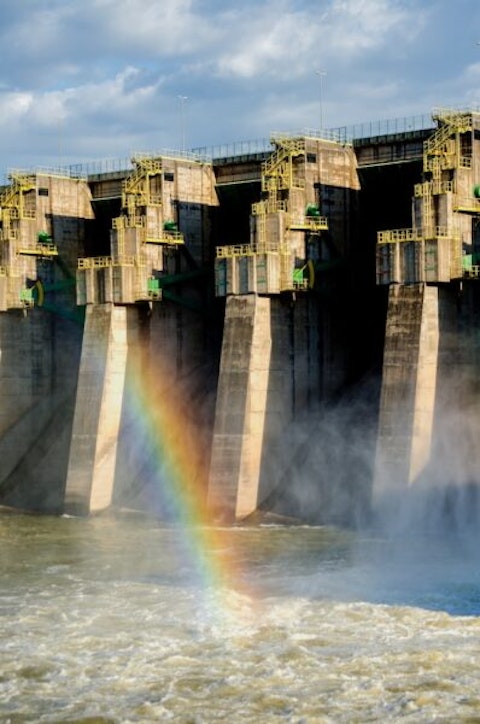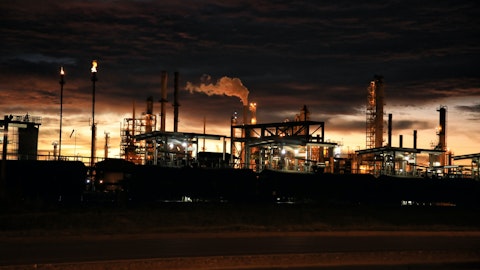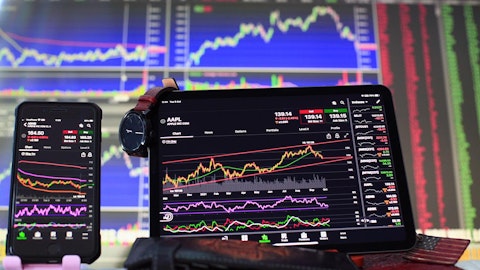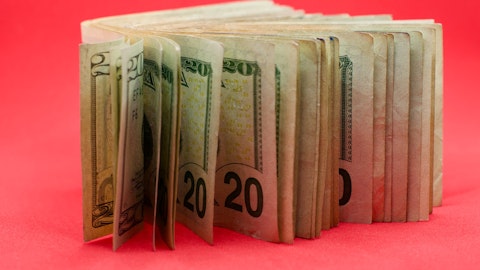Kinder Morgan, Inc. (NYSE:KMI) Q4 2022 Earnings Call Transcript January 18, 2023
Operator: Welcome to the quarterly earnings conference call. At this time all participants are in a listen-only mode. Today’s call is being recorded. If you have objections, please disconnect at this time. I’ll now turn the call over to Mr. Rich Kinder, Executive Chairman of Kinder Morgan. Sir, you may begin.

Photo by Gabriel on Unsplash
Rich Kinder: Thank you, Ted. And as usual, before we begin, I’d like to remind you that KMI’s earnings release today and this call include forward-looking statements within the meaning of the Private Securities Litigation Reform Act of 1995 and the Securities and Exchange Act of 1934 as well as certain non-GAAP financial measures. Before making any investment decisions, we strongly encourage you to read our full disclosures on forward-looking statements and use of non-GAAP financial measures set forth at the end of our earnings release as well as review our latest filings with the SEC for important material assumptions, expectations and risk factors that may cause actual results to differ materially from those anticipated and described in such forward-looking statements.
As we begin 2023, it seems to be an appropriate time to look both backward and forward. Through the rearview mirror of today’s earnings release, we see that 2022 was a very good year for Kinder Morgan. We again produced strong cash flow well in excess of our budget and used that cash flow to pay our investors a healthy and growing dividend, fund our expansion CapEx, maintain a strong balance sheet and buy back shares on an opportunistic basis. In short, we are continuing to follow the financial philosophy that we have stressed for years. Looking forward, we released in December, our preliminary budget for 2023 and shows another year of living within our means, even in the light of increased interest costs and an expanded set of expansion CapEx opportunities which should drive nice growth in 2024 and beyond.
We also announced today our plan for management succession. Our CEO, Steve Kean, will transition out of his role effective on August 1st of this year. Let me just say that Steve has been a superb CEO for the last eight years, and we thank him for the dedication, the hard work, confidence and honesty he’s brought to this job. On a personal note, he’s been a real pleasure to work with during all his years at the Company. While we will be sorry to lose him as CEO, we are delighted that we have him in his present role until August and that thereafter, he will continue to be a director, and I know he will contribute in that role to the future success of the Company. The Board and I have great faith in Kim Dang, who will transition from her present role as President into the CEO slot, and then Tom Martin, who will succeed her as President.
Both have been with Kinder Morgan for approximately 20 years, have made extraordinary contributions to our results and culture, and we expect great things from them in the future. To sum it up, we expect a smooth transition later this year. Steve?
Steve Kean: Thank you, Rich. I’ll give you a brief look back at what we did in 2022 and how well we have set ourselves up for the future. Kim and David will cover the substance and the details of our performance, and then we’ll take your questions. Next week, we have our comprehensive annual investor conference. So, as usually is the case on this call, we’ll defer to next week the more detailed questions on the 2023 budget and the outlook and business unit performance. As Rich said, we had a very strong year in 2022 and wrapped it up with a great fourth quarter. Late in the fourth quarter, for example, we saw some volatility in the gas market, and that creates opportunity for large transmission and storage operators like us and for our customers who procure transportation and storage services from us.
We performed well operationally for our customers financially for our company. Thanks, as always, to the tireless preparation and execution of our commercial, logistics and operations teams. We saw that come through, especially during the holiday weekend, when our teams work seamlessly across organizational lines to prepare, respond and recover and deal with the upsets along the way. That requires a committed workforce and a strong culture, and we’ve got that at Kinder Morgan. Our work in 2022 also set us up well for the future. We added to the strength of our balance sheet, finishing the year at 4.1 times debt to EBITDA better than our 4.3x budget for the year and well inside our long-term target of approximately 4.5 times. We originated new business, which has grown our backlog to $3.3 billion made up of high probability projects at an extremely attractive EBITDA multiple of about 3.4 times.
These investments are weighted toward our lower carbon future in natural gas, renewable liquid feedstocks and fuels in our products and terminals businesses, and investments in our Energy Transition Ventures business. And these lower carbon investments are all expected to yield very attractive returns well above our cost of capital. That’s how we told our investors we would approach these opportunities, and that’s exactly what we are doing. There are no loss leaders here. We also returned value to shareholders in the form of a well-covered modestly growing dividend and additional share repurchases. For 2022 alone, we’ve returned nearly $2.9 billion to shareholders and declared dividends and share repurchases. On the share repurchases, we have used a little under $1 billion of the Board authorized amount, and the Board has now upsized the total authorization from $2 billion to $3 billion.
As always, those will be opportunistic repurchases when we use that capacity. Also, as we talked about throughout the year, we’re starting to see nice uplift on our base business, on renewals in our natural gas business and built-in escalators in some of our products and terminals, tariffs and contracts. We are putting behind us the contract roll-off headwinds in our gas group. Bottom line for investors, what we do today will be needed for decades to come. And as we are demonstrating in our products and terminals businesses, the assets we have today can accommodate the energy forms of the future. We are making the gradual pivot that the gradual energy evolution dictates, and we’re doing it at attractive returns for our investors. With the cash our businesses generate, we’re maintaining that strong balance sheet, we are investing in projects with good returns, which adds to the value of the Company, and we are returning the excess to our shareholders in the form of dividends and opportunistic share repurchases.
We all appreciate Rich’s comments at the beginning, and I’m grateful to Rich and the Board for their support and confidence in us. I’m grateful to my 10,000 colleagues here who have been proud to come to work with every day. And I’m grateful to you on the call who I have interacted with over the years, I learned from you and benefited from your questions and perhaps your occasional criticisms and your ideas. Thank you. As you’ll hear more about next week, we have our balance sheet in strong shape. We have a bright future with rich opportunities before us. And most importantly, we have a great experienced leadership team around this table who are always ready to step up and all of our investors benefit from that. We look forward to seeing you in person at the conference next week.
Kim?
Kim Dang: Thanks, Steve. Okay. I’m going to start with our Natural Gas business unit. Transport volumes on our Natural Gas Pipelines increased by about 4% for the quarter versus the fourth quarter of 21. We saw increased volumes from power demand and LDCs as a result of weather and coal retirements, and that was somewhat offset by reduced LNG volumes due to the Freeport outage and exports to Mexico as a result of third-party pipeline capacity added to the market. Physical deliveries to LNG facilities off of our pipes averaged approximately 5.4 million dekatherms per day. That’s down about 450,000 dekatherms per day versus Q4 of 21, and that’s due to the Freeport outage and somewhat offset by increased deliveries to Sabine Pass.
If we adjusted for the Freeport outage, LNG volumes would have increased approximately 5%. Deliveries to power plants and LDCs were robust in the quarter, up approximately 7% and 13%, respectively, driven by the weather. Our natural gas gathering volumes were up 6% in the quarter, driven by Haynesville volumes, which were up 44%. Sequentially, volumes were flat. In our Products segment, refined products volumes were down a little under 1% for the quarter, slightly outperforming the EIA, which was down 2%. Road fuels were down 3%, but we saw a 10% increase in jet fuel demand. Crude and condensate volumes were down 6% in the quarter due to lower Bakken volumes. Sequential volumes were down about 3%, and that was driven by lower HH volumes. That’s a pipe coming out of the Bakken due to unattractive locational pricing differentials.
In our Terminals business segment, our liquids utilization percentage, think about that as a percentage of our tank capacity contracted, remained high at 93%. Excluding tanks out of service for required inspection, utilization is approximately 96%. Rates on liquids tanks renewals in Houston and New York Harbor were slightly lower in the quarter. Our tankers business was up nicely in the quarter as we benefited from both, higher rates and higher utilization. On the bulk side, overall volumes were down 2%. We saw increases in pet coke and coal volumes, but that was more than offset by lower steel volume. In our CO2 segment, prices were up across the board. On the volume side, oil production was flat, but it’s up 8% versus our budget. CO2 volumes were up 12%.
NGL volumes, which are much less impactful to results were down 4%. Overall, both Steve and Rich have said, we had a fantastic quarter and year. For the quarter, DCF per share was up 13% and for the full year, it was up 14% when you exclude the impact of Winter Storm Uri. We exceeded our full year planned DCF and EBITDA by 5% and DCF per share by 6% coming in at or slightly above the numbers we have given you in the interim quarters. This is an amazing year for a stable fee-based cash flow company like Kinder Morgan. For sure, we benefited from higher commodity prices but our underlying business of specialty natural gas performed incredibly and the fundamentals look strong for the future, which we will cover with you next week at the investor conference.
With that, I’ll turn it over to David.
See also 11 Best Debt Free Stocks To Buy and 14 Best Dividend Stocks To Buy and Hold.
David Michels: All right. Thanks, Kim. So for the fourth quarter of 2022, we’re declaring a dividend of $0.2775 per share, which is $1.11 per share annualized and up 3% from our 21 dividend. I’ll start with a few highlights on leverage, liquidity, growth and shareholder value. There’s some repetition here with earlier comments, but it’s worth it. On leverage, we ended 2022 with the lowest year-end net debt level since our 2014 consolidation transaction, and we have plenty of cushion under our leverage target of around 4.5 times. For liquidity, we ended 2022 with $745 million of cash on our balance sheet in addition to our undrawn $4 billion worth of revolver capacity. Growth for full year 2022 versus 21 excluding the impacts from Winter Storm Uri, as Kim mentioned, we grew nicely.
On a net income basis, we were up almost 3 times 2021. That’s partially due to an impairment taken in 2021. And on EBITDA, we’re up 10%, and on DCF per share we’re up 14% year-over-year, very nice growth. For shareholder value for full year 2022, we repurchased 21.7 million shares at an average price of $16.94 per share and our Board just authorized us to do more of that, should the opportunity present itself. We’re seeing healthy growth across our business. Our balance sheet and liquidity are strong as they ever have been, and we’re creating shareholder value across the Company in multiple ways. So moving on to our quarterly performance. In the fourth quarter, we generated revenue of $4.6 billion, up $154 million from the fourth quarter of 2021.
Our net income was up — was $670 million, up 5% from the fourth quarter of last year. And our adjusted earnings, which excludes certain items, was up 16% compared to the fourth quarter of 21. Our distributable cash flow performance was also very strong. Our Natural Gas segment was up 11% or $138 million, with growth coming from multiple assets, higher contributions from our Texas Intrastate systems, MEP and EPNG, increased volumes on our KinderHawk system and favorable pricing on our Altamont system. Those were partially offset by lower contributions from our South Texas gathering assets. The Products segment was down $29 million, driven by higher operating expenses as well as lower contributions from our crude and condensate business, and those were partially offset by increased rates across multiple assets as well as strong volumes on our splitter system.
The Terminal segment was flat to the fourth quarter of 21 with slightly lower New York Harbor and Houston Ship Channel liquids refined product renewal rates, unfavorable impacts from the 2022 winter weather and unfavorable property taxes, offset by greater contributions from our Jones Act tanker business, nonrecurring impacts from Hurricane Ida in 2021 and contributions from expansion projects placed in service as well as other rate escalations that the segment experienced. Our CO2 segment was up $36 million from the fourth quarter of 21, driven mostly by favorable commodity prices. Our EBITDA was $1.957 billion, up 8% from last year, and DCF was $1.217 billion, up 11% from last year. Our DCF per share of $0.54 was up 13% from last year.
Moving on to the balance sheet. We ended the fourth quarter with $30.9 billion of net debt and a net debt to adjusted EBITDA ratio of 4.1 times. That’s up from 3.9 times from year-end 21, but that’s due to the nonrecurring EBITDA contribution from Winter Storm Uri we experienced in 2021. Excluding that Winter Storm Uri, EBITDA contribution that year-end 2021 ratio was 4.6 times. So we ended the quarter and the year nicely favorable to the metric excluding Uri contribution. We’re also nicely below our long-term leverage target of around 4.5 times. Our net debt change for the full year of $278 million was driven by a number of things. So, here’s a high-level reconciliation of that. Our DCF generated $4.97 billion. We paid out $2.46 billion in dividends.
We spent $1.1 billion on growth capital and JV contributions. We repurchased stock in the amount of $368 million. We made two renewable natural gas acquisitions for around $500 million. And we received $560 million approximately from the sale of a partial interest in our Elba Liquefaction company. Finally, we had a working capital use of around $825 million from several items, and that gets you close to the $278 million reduction in net debt year-to-date.
Kim Dang: Okay. Before we start with questions, I am very excited about the opportunity ahead. A large part of my job is going to be about continuity. This is a great company and great business with a great future. As Steve said, our traditional business will be around for a long time to come. Energy is a $5 trillion global industry that is ingrained in every aspect of our lives. We will continue to invest wisely as we position the Company to turn slowly over time with the transition in a profitable manner. I’m also excited to work more directly with Tom. We work well together and have complementary skills, which will help the Company into the future. We have an experienced cohesive senior management team with Dax and John and Anthony and Sital and David and Kevin and others sitting around this table, and we expect to make this a seamless transition.
Steve Kean: All right. Okay. Ted, let’s open it up for questions. And as usual, we have a good chunk of our senior management team around the table. We’ll make sure that you get a chance to hear from them as you have questions about their businesses specifically. So Ted, if you would open it up to questions.
Q&A Session
Follow Kinder Morgan Inc. (NYSE:KMI)
Follow Kinder Morgan Inc. (NYSE:KMI)
Operator: The first question in the queue is from Jeremy Tonet with JP Morgan.
Jeremy Tonet: Just want to say congratulations to everyone, and Steve, best of luck going forward. And maybe just starting off, I guess, with capital allocation, wondering if you could touch on any updated thoughts there. It seems like the dividend uptick might have been a little bit less than expected. And then, at the same time, the share authorization levels were increased when it wasn’t fully utilized before. So just wondering, is it signaling any kind of shift in capital allocation or any other thoughts there on return on capital?
Steve Kean: Yes. I’ll start. I mean, it doesn’t imply any shift or change in approach at all. We look to maintain the strong balance sheet as all four of us have said, and we look to fund projects at attractive returns. And as mentioned, we have some very good ones, $3.3 billion at a 3.4x EBITDA multiple. Those add to the value of the firm. Those are attractive returns to us. But then, we have — we’ve produced cash beyond that. And that cash takes the — gets returned to shareholders in the form of a modestly growing and well-covered dividend and share repurchases. The capacity — the reason for upsizing the capacity is not a change in terms of how we’re thinking about it. Opportunistic, as we’ve all said, and we’ve been saying for a long time.
But we’ve used about $900 million since the original authorization, a little over $900 million. And so, we’ll be ready to take advantage of opportunities we upsize — the Board upsize the authorization. And so, we’re in a position to take advantage of opportunities as they arise. But overall, bottom line, we haven’t changed our capital allocation philosophy. It’s worked. It’s been the same for quite a while. And it adds value for our shareholders.
Kim Dang: Yes. And on the dividend, what I would say is that it’s important — we believe it’s important to increase the dividend when the Company is growing. And — but we do — we are one of the top 10 dividend yields in the S&P 500. And so, we already have an attractive yield on the stock. And so, it’s a small increase so that we continue to increase in terms of being a good dividend paying stock, but also recognizing where the yield on the stock is.
Jeremy Tonet: Got it. Makes sense. That’s helpful there. And then just wanted to shift to the weather impact during the quarter, if maybe you could unpack that a little bit more as far as pros and cons. Were there any marketing uplift during the quarter? Just trying to see, I guess, what was the impact from the storm in the quarter.
Steve Kean: Yes. It’s — so look, we had uplift primarily in our Natural Gas assets. And that’s attributable to what I said at the beginning, which is that when you have storage and transport capacity, particularly in this case, storage where — Kim, I think the peak was 160 Bcf and we had some supply degradation. This is a nationwide look down to a little over 80 Bcf. The difference had to be made up with storage and people who had those assets and have the capability were able to do well in those. The net, though, we did have some operational upsets and repairs we had to make, et cetera. And so, we netted those out. And it’s not — the storm itself is not a huge incremental contributor. It’s on the order of $20 million or so when you net everything.





